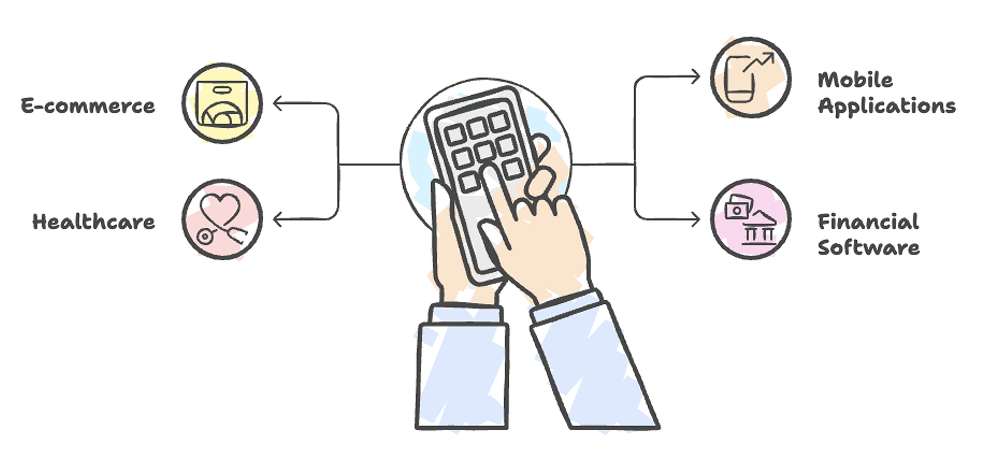As software development accelerates, traditional testing methods struggle to keep up. Manual testing takes time, automation scripts break easily, and bugs still manage to sneak through. This is where AI testing steps in. By using artificial intelligence and machine learning, testing becomes faster, smarter, and much easier to scale.
What is AI Testing?
AI testing is a modern approach to software testing that uses artificial intelligence (AI) and machine learning (ML) to improve test automation. Instead of relying solely on hard-coded scripts, AI tools can adapt to changes in the UI by automatically updating locators or suggesting fixes for broken test scripts.
Types of AI Testing
AI can support many types of software testing. It doesn’t just run checks-it adapts and learns, making it useful for:
- Functional testing: Confirms that app features work as expected.
- Regression testing: Checks that updates don’t break old features.
- Performance testing: Simulates user traffic to test speed and stability.
- Security testing: Uses AI to scan for vulnerabilities or weak points.
- Exploratory testing: Detects unexpected issues based on real user behavior.
Benefits of AI Testing
AI in software testing offers numerous benefits that contribute to more agile, scalable, and error-resistant development workflows:
- Faster releases: AI accelerates testing, enabling teams to ship updates more quickly.
- Lower costs: Less manual work means reduced testing effort.
- Fewer errors: AI helps cut down false positives and missed bugs.
- Wider coverage: It can simulate many devices, browsers, and user actions.
- CI/CD friendly: Works well with modern development pipelines.
Challenges in Traditional Automation
Traditional automation testing faces several challenges that can limit its effectiveness. These issues often lead to increased costs and inefficiencies. Key challenges include:
- High maintenance: Tests break frequently due to UI updates.
- Rigid test cases: Hardcoded assertions struggle with minor design changes.
- Limited intelligence: Conventional automation lacks adaptability.
- Manual effort: Exploratory and usability testing requires human intervention.
Common Use Cases for AI in Testing
AI testing is not just theoretical-it’s already reshaping quality assurance across industries. Below are practical examples of how AI in software testing is applied in real-world systems to reduce errors, accelerate release cycles, and improve test coverage.

1. E-commerce Platforms
E-commerce apps are dynamic by nature, with frequently changing product catalogs, promotions, and payment options.
How AI helps:
- Validates complete user journeys (browsing → cart → checkout)
- Automatically adapts tests when UI elements like “Add to Cart” change
- Uses visual AI to detect layout breaks across devices and screen sizes
- Monitors third-party integrations (e.g., Stripe, PayPal) for reliability
2. Mobile Applications
With hundreds of screen sizes and OS combinations, manually scaling mobile app testing is challenging.
How AI helps:
- Tests apps across iOS, Android, and various device models simultaneously
- Detects visual anomalies like clipped buttons or off-center text
- Simulates real user gestures such as swipes, pinches, or biometric login
- Auto-heals test scripts when the UI changes after a release
3. Financial & Banking Software
Financial applications have strict security and compliance requirements. A bug in transaction logic could result in serious legal and financial consequences.
How AI helps:
- Advanced tools like Launchable and TestBrain use AI to prioritize testing by analyzing bug history and code change frequency.
- Prioritizes test cases for payment flows, loan processing, and user authentication
- Supports negative testing and edge case simulation (e.g., failed payment retries)
- Enhances regression testing for financial algorithms and reporting
4. Healthcare Applications
In healthcare, bugs aren’t just annoying-they can put patient safety at risk. Testing here needs to be robust, repeatable, and compliant with regulations like HIPAA or GDPR.
How AI helps:
- Validates end-to-end workflows like appointment booking, test results, or prescriptions
- Detects UI inconsistencies in electronic health record (EHR) interfaces
- Ensures form inputs and sensitive data fields behave as expected across roles (e.g., doctor vs. nurse)
- Simulates load testing for emergency response portals or vaccination scheduling apps
Implementing AI in Software Testing
Getting started with AI-powered testing takes planning. Here’s a simple path to implement AI in your software testing processes:
- Choose the right AI testing tool: Select a platform that fits your software requirements.
- Define test scenarios: Identify areas where AI can bring efficiency.
- Train AI models: Use historical test data to help the tool improve predictions if the platform supports it.
- Execute AI-powered tests: Run automated scripts and refine them based on feedback.
- Monitor and optimize: Continuously assess AI-driven testing for improvement.
Conclusion
AI is transforming software testing processes. It enables teams to work more efficiently, increases the number of bugs identified, and reduces the time spent resolving test-related issues. With smart tools and the right strategy, your team can benefit from AI that helps you with test automation while keeping things simple, scalable, and future-proof.
